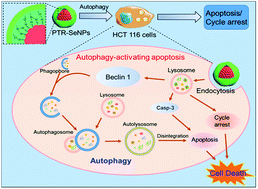Autophagy is an important action mode for functionalized selenium nanoparticles to exhibit anti-colorectal cancer activity†
Abstract
Selenium nanoparticles (SeNPs) have attracted much interest as potential anticancer nanodrugs. Our previous studies also demonstrated that SeNPs could be developed as carriers of clinically used anticancer drugs to achieve synergistic efficacy. Here, we describe the synthesis of Pleurotus tuber-regium (PTR)-conjugated SeNPs (PTR-SeNPs) and their application in the treatment of colorectal cancer (CRC), which is one of the principal causes of cancer morbidity and mortality in the world. PTR-SeNPs were absorbed by cancer cells via clathrin-mediated endocytosis into lysosomes and caveolae-mediated endocytosis into the Golgi apparatus. Internalized PTR-SeNPs trigger intracellular dose- and time-dependent G2/M phase arrest and apoptosis. Moreover, as shown by using a pEGFP-LC3 plasmid transfection model, PTR-SeNPs activate autophagy to promote the death of cancer cells via upregulation of beclin 1-related signaling pathways. In summary, this study demonstrates the high efficacy of functionalized SeNPs for therapy of colorectal cancer and reveals the important role of autophagy in promoting apoptosis and cell cycle arrest to induce cell death.



 Please wait while we load your content...
Please wait while we load your content...